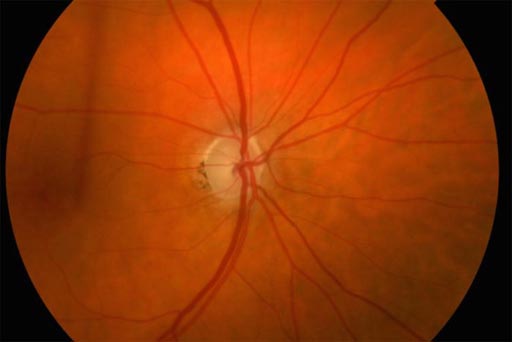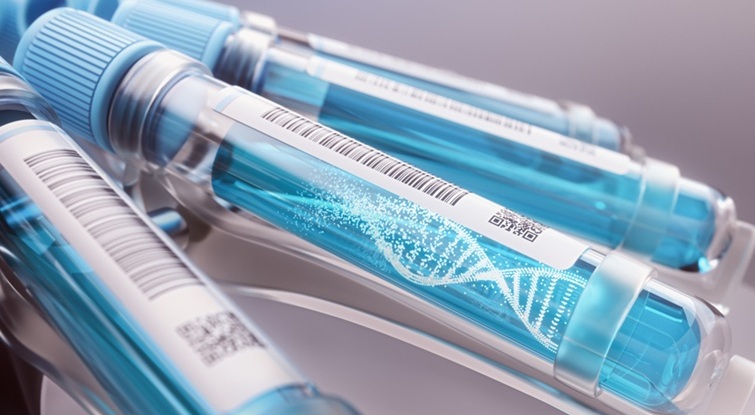Biomarker Traces Glaucoma Development and Progression
|
By LabMedica International staff writers Posted on 17 May 2017 |

Image: At the center of the image is an optic nerve with glaucoma damage, signified by loss of color and a round rim of pink tissue within the nerve (Photo courtesy of Carla J. Siegfried, Washington University School of Medicine).
A potential biomarker protein has been identified that was elevated in rodent models of glaucoma and in fluid taken from the eyes of human patients with the disease.
Glaucoma is the second leading cause of blindness worldwide. Physicians often use rather arbitrary endpoints to monitor the progression of glaucomatous neurodegeneration. These approaches are limited in their ability to quantify disease severity and progression due to inherent subjectivity, unreliability, and limitations of normative databases.
Investigators at Washington University School of Medicine worked initially with a mouse glaucoma model to try to identify molecular markers linked to development and progression of the disease.
They reported in the May 4, 2017, online edition of the journal JCI Insight that the protein growth differentiation factor 15 (Gdf15) was associated with retinal ganglion cell death. Gdf15 expression in the retina was specifically increased after acute injury to retinal ganglion cell axons and in a mouse chronic glaucoma model. Working with a rat glaucoma model, they further demonstrated that the ganglion cell layer was probably one of the sources of secreted Gdf15 and that Gdf15 diffused to and could be detected in aqueous humor (AH) of the eye.
In validating these findings in human patients with glaucoma, the investigators found not only that Gdf15 was increased in AH of patients with primary open angle glaucoma (POAG), but also that elevated Gdf15 levels were significantly associated with worse functional outcomes in glaucoma patients, as measured by visual field testing.
"That was exciting because comparing the fluid from patients without glaucoma to those with glaucoma, the Gdf15 biomarker was significantly elevated in the glaucoma patients," said senior author Dr. Rajendra S. Apte, professor of ophthalmology and visual sciences at Washington University School of Medicine. "We also found that higher levels of the molecule were associated with worse functional outcomes, so this biomarker seems to correlate with disease severity."
"There has not been a reliable way to predict which patients with glaucoma has a high risk of rapid vision loss," said Dr. Apte. "But we have identified a biomarker that seems to correlate with disease severity in patients, and what that marker is measuring is stress to the cells rather than cell death. Other glaucoma tests are measuring cell death, which is not reversible, but if we can identify when cells are under stress, then there is the potential to save those cells to preserve vision."
Glaucoma is the second leading cause of blindness worldwide. Physicians often use rather arbitrary endpoints to monitor the progression of glaucomatous neurodegeneration. These approaches are limited in their ability to quantify disease severity and progression due to inherent subjectivity, unreliability, and limitations of normative databases.
Investigators at Washington University School of Medicine worked initially with a mouse glaucoma model to try to identify molecular markers linked to development and progression of the disease.
They reported in the May 4, 2017, online edition of the journal JCI Insight that the protein growth differentiation factor 15 (Gdf15) was associated with retinal ganglion cell death. Gdf15 expression in the retina was specifically increased after acute injury to retinal ganglion cell axons and in a mouse chronic glaucoma model. Working with a rat glaucoma model, they further demonstrated that the ganglion cell layer was probably one of the sources of secreted Gdf15 and that Gdf15 diffused to and could be detected in aqueous humor (AH) of the eye.
In validating these findings in human patients with glaucoma, the investigators found not only that Gdf15 was increased in AH of patients with primary open angle glaucoma (POAG), but also that elevated Gdf15 levels were significantly associated with worse functional outcomes in glaucoma patients, as measured by visual field testing.
"That was exciting because comparing the fluid from patients without glaucoma to those with glaucoma, the Gdf15 biomarker was significantly elevated in the glaucoma patients," said senior author Dr. Rajendra S. Apte, professor of ophthalmology and visual sciences at Washington University School of Medicine. "We also found that higher levels of the molecule were associated with worse functional outcomes, so this biomarker seems to correlate with disease severity."
"There has not been a reliable way to predict which patients with glaucoma has a high risk of rapid vision loss," said Dr. Apte. "But we have identified a biomarker that seems to correlate with disease severity in patients, and what that marker is measuring is stress to the cells rather than cell death. Other glaucoma tests are measuring cell death, which is not reversible, but if we can identify when cells are under stress, then there is the potential to save those cells to preserve vision."
Latest BioResearch News
- Genome Analysis Predicts Likelihood of Neurodisability in Oxygen-Deprived Newborns
- Gene Panel Predicts Disease Progession for Patients with B-cell Lymphoma
- New Method Simplifies Preparation of Tumor Genomic DNA Libraries
- New Tool Developed for Diagnosis of Chronic HBV Infection
- Panel of Genetic Loci Accurately Predicts Risk of Developing Gout
- Disrupted TGFB Signaling Linked to Increased Cancer-Related Bacteria
- Gene Fusion Protein Proposed as Prostate Cancer Biomarker
- NIV Test to Diagnose and Monitor Vascular Complications in Diabetes
- Semen Exosome MicroRNA Proves Biomarker for Prostate Cancer
- Genetic Loci Link Plasma Lipid Levels to CVD Risk
- Newly Identified Gene Network Aids in Early Diagnosis of Autism Spectrum Disorder
- Link Confirmed between Living in Poverty and Developing Diseases
- Genomic Study Identifies Kidney Disease Loci in Type I Diabetes Patients
- Liquid Biopsy More Effective for Analyzing Tumor Drug Resistance Mutations
- New Liquid Biopsy Assay Reveals Host-Pathogen Interactions
- Method Developed for Enriching Trophoblast Population in Samples
Channels
Clinical Chemistry
view channel
Blood Test Could Predict and Identify Early Relapses in Myeloma Patients
Multiple myeloma is an incurable cancer of the bone marrow, and while many patients now live for more than a decade after diagnosis, a significant proportion relapse much earlier with poor outcomes.... Read more
Compact Raman Imaging System Detects Subtle Tumor Signals
Accurate cancer diagnosis often depends on labor-intensive tissue staining and expert pathological review, which can delay results and limit access to rapid screening. These conventional methods also make... Read moreMolecular Diagnostics
view channel
Multiplex Antibody Assay Could Transform Hepatitis B Immunity Testing
Hepatitis B remains a major global health challenge, yet immunity testing has historically been constrained by cost, operational complexity, and single-analyte approaches. Now, a multiplex antibody assay... Read more
Genetic Testing Improves Comprehensive Risk-Based Screening for Breast Cancer
Breast cancer screening has long relied on age-based guidelines, assuming similar risk across all women despite clear evidence that individual risk varies widely. This one-size-fits-all approach can lead... Read more
Urine Test Could Reveal Real Age and Life Span
Chronological age does not always reflect how quickly the body is aging, as biological age is shaped by genetics, stress, sleep, nutrition, and lifestyle factors such as smoking. A higher biological age... Read more
Genomic Test Identifies African Americans at Risk for Early Prostate Cancer Recurrence
Prostate cancer is one of the most commonly diagnosed cancers in men and a leading cause of cancer-related death, particularly in the United States. African American men face a disproportionately higher... Read moreHematology
view channel
MRD Tests Could Predict Survival in Leukemia Patients
Acute myeloid leukemia is an aggressive blood cancer that disrupts normal blood cell production and often relapses even after intensive treatment. Clinicians currently lack early, reliable markers to predict... Read more
Platelet Activity Blood Test in Middle Age Could Identify Early Alzheimer’s Risk
Early detection of Alzheimer’s disease remains one of the biggest unmet needs in neurology, particularly because the biological changes underlying the disorder begin decades before memory symptoms appear.... Read more
Microvesicles Measurement Could Detect Vascular Injury in Sickle Cell Disease Patients
Assessing disease severity in sickle cell disease (SCD) remains challenging, especially when trying to predict hemolysis, vascular injury, and risk of complications such as vaso-occlusive crises.... Read more
ADLM’s New Coagulation Testing Guidance to Improve Care for Patients on Blood Thinners
Direct oral anticoagulants (DOACs) are one of the most common types of blood thinners. Patients take them to prevent a host of complications that could arise from blood clotting, including stroke, deep... Read moreImmunology
view channel
Ultrasensitive Liquid Biopsy Demonstrates Efficacy in Predicting Immunotherapy Response
Immunotherapy has transformed cancer treatment, but only a small proportion of patients experience lasting benefit, with response rates often remaining between 10% and 20%. Clinicians currently lack reliable... Read more
Blood Test Could Identify Colon Cancer Patients to Benefit from NSAIDs
Colon cancer remains a major cause of cancer-related illness, with many patients facing relapse even after surgery and chemotherapy. Up to 40% of people with stage III disease experience recurrence, highlighting... Read moreMicrobiology
view channel
New UTI Diagnosis Method Delivers Antibiotic Resistance Results 24 Hours Earlier
Urinary tract infections affect around 152 million people every year, making them one of the most common bacterial infections worldwide. In routine medical practice, diagnosis often relies on rapid urine... Read more
Breakthroughs in Microbial Analysis to Enhance Disease Prediction
Microorganisms shape human health, ecosystems, and the planet’s climate, yet identifying them and understanding how they are related remains a major scientific challenge. Even with modern DNA sequencing,... Read morePathology
view channel
Genetics and AI Improve Diagnosis of Aortic Stenosis
Aortic stenosis is a progressive narrowing of the aortic valve that restricts blood flow from the heart and can be fatal if left untreated. There are currently no medical therapies that can prevent or... Read more
AI Tool Simultaneously Identifies Genetic Mutations and Disease Type
Interpreting genetic test results remains a major challenge in modern medicine, particularly for rare and complex diseases. While existing tools can indicate whether a genetic mutation is harmful, they... Read more
Rapid Low-Cost Tests Can Prevent Child Deaths from Contaminated Medicinal Syrups
Medicinal syrups contaminated with toxic chemicals have caused the deaths of hundreds of children worldwide, exposing a critical gap in how these products are tested before reaching patients.... Read more
Tumor Signals in Saliva and Blood Enable Non-Invasive Monitoring of Head and Neck Cancer
Head and neck cancers are among the most aggressive malignancies worldwide, with nearly 900,000 new cases diagnosed each year. Monitoring these cancers for recurrence or relapse typically relies on tissue... Read moreTechnology
view channel
Pioneering Blood Test Detects Lung Cancer Using Infrared Imaging
Detecting cancer early and tracking how it responds to treatment remains a major challenge, particularly when cancer cells are present in extremely low numbers in the bloodstream. Circulating tumor cells... Read more
AI Predicts Colorectal Cancer Survival Using Clinical and Molecular Features
Colorectal cancer is one of the most common and deadly cancers worldwide, and accurately predicting patient survival remains a major clinical challenge. Traditional prognostic tools often rely on either... Read moreIndustry
view channel
BD and Penn Institute Collaborate to Advance Immunotherapy through Flow Cytometry
BD (Becton, Dickinson and Company, Franklin Lakes, NJ, USA) has entered into a strategic collaboration with the Institute for Immunology and Immune Health (I3H, Philadelphia, PA, USA) at the University... Read more



















